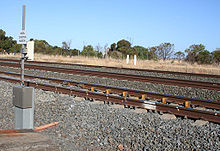- Defect detector
-
A defect detector is a device used on railroads to detect axle and signal problems in passing trains. The detectors are normally integrated into the tracks and often include sensors to detect several different kinds of problems that could occur. Defect detectors were one invention which enabled American railroads to eliminate the caboose at the rear of the train, as well as various station agents stationed along the route to detect unsafe conditions. The use of defect detectors has since spread to other overseas railroads.
Contents
History
As early as the 1940s, automatic defect detectors were installed to improve what was normally done with the human eye by railroad workers. The detectors would transmit their data via wired links to remote read-outs in stations, offices or interlocking towers. If a defect was detected, an alarm would sound and the employee on duty would bring the train to a halt using hand or automatic signals.
Today
Beginning in the 1980s many North American Class I railroads began adding radio transmitters and mechanical voices to their defect detectors; as trains passed detectors, the mechanical or pre-recorded voice would sound out on the railroad's main road radio channel that a train has passed and note any defects that were found. Most often, after a train has passed such an equipped detector, the mechanical voice will report the railroad name, milepost or location, track number (if applicable), number of axles on the train that passed and the phrase "no defects" to indicate that no problems were detected on the train. Sometimes the location's ambient temperature and train speed are also noted by the mechanical voice. When a problem is detected, the mechanical voice will often start with a long, high pitch alarm tone followed by a description of the problem and the axle position within the train where the problem occurred. Crews can use their touch-tone hand radios to get the detector to repeat error messages. Defect detectors that are equipped with such a mechanical voice are often called talking detectors by railfans.
To this day some rail lines, mostly passenger routes with a very high traffic density, maintain centralized readout, non-talking detectors. This is due to the large and confusing volume of radio traffic a talking detector would generate. When an error signal is received a dispatcher or operator will contact the train via radio manually transmitting the error message and required action (like slow down, stop at next station or immediately stop).
Today defect detectors are often incorporated in monitoring platforms that are primarily used by railroads to more closely monitor the status of their trains. In countries where rail transport has been liberalised infrastructure companies use defect detectors to check the quality and status of different train owners. The main concern of the infra owner is protecting their asset and preventing excessive damage. However, studies have been conducted to see whether defect detectors can be used to issue "penalties" track-unfriendly vehicles (or provide discounts to those operators with track-friendly vehicles).[1]
Talking detectors are also used by railfans that are carrying scanners to listen in on the railroad's radio chatter. Railfans are often able to gauge where trains are by listening for the detectors' transmissions; in doing so, the railfans can more precisely predict when a train will pass a specific location to improve their chances of photographing the trains.
Sensors
The sensors installed at defect detector locations can include:
- Hotbox detectors
- Dragging equipment detectors
- Wheel impact or sliding wheel detectors (often placed at the entrances of delicate high speed track like Amtrak's Northeast Corridor)
- High car or shifted load detectors
- Weighing in Motion sensors for axle loads, imbalances or infracharging
- Wide-load detectors
- Hot-Wheel Detection (caused by sticking brake)
See also
References
- ^ Andrew Grantham "Raising loads and lowering charges", Europen Railway Review,1 November 2003.
External links
- Audio: CONRAIL Talking Detector in Depew, New York (.wav file)
- Audio: CONRAIL Talking Detector in Lancaster, New York (.wav file)
- Photos: 'Wheel Impact Load Detector' at Lara, Australia
- Western New York Railway Historical Society - (more talking detector audio clips)
Categories:- Rail infrastructure
- Rail technologies
- Railway safety
- Train protection systems
Wikimedia Foundation. 2010.


